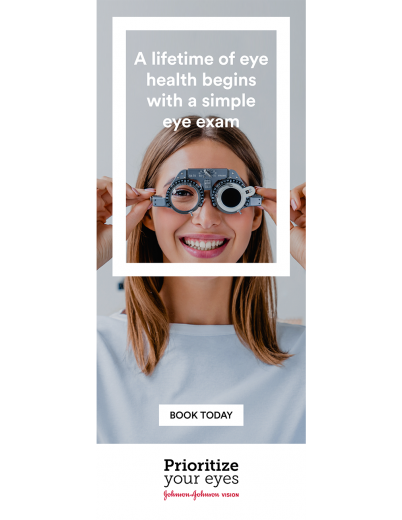Amidst the COVID-19 Pandemic, Early Intervention Remains an Obstacle for Overall Eye Health Despite Fear of Blindness


Second annual J&J Vision Global Eye Health Survey reveals that people aren’t taking proactive measures to keep their eyes healthy, yet sight is the sense people most fear losing.
JACKSONVILLE, Fla. and SANTA ANA, Calif., – October 14, 2021 – Globally, most adults, 70 percent, don’t plan to get their eyes examined this year, despite acknowledging the critical importance of eye health. These new findings come from a comprehensive, large-scale Johnson & Johnson Vision Global Eye Health Survey announced in advance of World Sight Day on October 14, 2021.
This year’s survey, from Johnson & Johnson Vision, a global leader in eye health and part of the Johnson & Johnson Medical Devices Companies1, revealed key insights around the impact of the pandemic on eye health, misbeliefs about vision correction options for aging eyes, the intersection between eye health and beauty, and the high potential for missed early intervention for children with vision correction needs. Serving as the cornerstone of J&J Vision’s Prioritize Your Eyes campaign, the survey was launched in advance of World Sight Day in an effort to raise awareness about the importance of getting an annual eye exam, both for adults and children alike.
"At Johnson & Johnson Vision, we are committed to changing the trajectory of eye health—which starts with getting people to their annual comprehensive eye exams,” said Shlomi Nachman***, Company Group Chairman, Cardiovascular & Specialty Solutions Group and Johnson & Johnson Vision. “This year’s survey shows that, globally only 3 in 10 people have scheduled or plan to schedule an annual eye exam as eye care offices have re-opened. With the Prioritize Your Eyes campaign and the annual eye health survey, our goal is to educate on the importance of getting to your eye care professional regularly—for the sake of your vision and your overall health.”
According to the survey, 86 percent of the world’s adult population fear losing their sight above any other sense. It is likely for this reason that globally, 88 percent of people view eye health maintenance a priority for their overall health. Counter to this statistic, however, is that only 52 percent of respondents say they get annual eye exams. In addition to vision correction and lifestyle support, an eye exam may help detect over 270 medical conditions—from diabetes to heart disease.2
Eye Health + The Pandemic
The survey reveals more than one-third believe their vision has deteriorated since the start of the pandemic. However, despite this reported awareness, 70 percent of all respondents said they don’t plan to schedule an eye exam in the year ahead—the single most important step to protect your eyes.
Click to Tweet: New eye health survey finds one-third believe their vision has deteriorated since the start of pandemic, but most don’t plan to schedule an eye exam. @JNJVision encourages you to #PrioritizeYourEyes by getting a comprehensive eye exam. Learn more + find a doctor here: https://bit.ly/3cH5HOb
The Challenge of Diagnosing Myopia in Children
Survey results show that although three-in-four (75%) parents indicate they believe it is more important for their child to receive an eye exam than it is for them—and the majority (61%) of parents indicate they’re concerned about their children being diagnosed as nearsighted (myopic)—only one-quarter (27%) plan to schedule an annual eye exam for their children. Myopia is sometimes called 'nearsightedness’ but it is much more.3 It is a chronic and progressive disease4,5,6 that poses the biggest eye health threat of the 21st Century.7 Half of the world’s population is projected to be myopic by 2050 with nearly one billion people expected to have high myopia.8 Children under 12 who are diagnosed with myopia are at greater risk of developing high myopia which may lead to sight threatening disease later in life.9,10
Beauty and Eye Health – Aging with Style
Astonishingly one-in-four respondents (27%) indicated they’re more concerned about how their eyes look than the health of their eyes. And, nearly 30 percent of respondents indicated they would change the color of their eyes for a day if they could.
For those with aging eyes, three in ten (29%) worry wearing glasses will make them look old or impacts their self-confidence (30%), yet only 37% of respondents know contact lenses are available as an alternative to multifocal glasses as they age. People don’t realize they don’t have to sacrifice aesthetics to improve their vision.
Don’t Wait on Cataracts
72% of respondents who had a cataract surgery said if they’d have known how much better their vision would be after cataract surgery, they would have done it sooner. And, 56% didn’t realize how bad their vision was until after surgery.
With 94 million people affected by cataracts worldwide11 the survey revealed that people may be delaying cataract treatment due to misbeliefs about the procedure. Less than half of all respondents (46%) realized cataract surgery is outpatient and only 31% realized the procedure can take less than 10 minutes to perform.
Find an eye care professional for a comprehensive eye exam here, make the commitment to #PrioritizeYourEyes, and spread the word with your loved ones.
###
About Prioritize Your Eyes
Prioritize Your Eyes was launched in early 2020 and is just one part of Johnson & Johnson Vision’s ongoing commitment and collaboration with various partners and professional organizations to elevate eye health to a global priority and address the barriers of awareness and access. Sight for Kids, a nonprofit program co-founded by Johnson & Johnson Vision and Lions Clubs International Foundation nearly 20 years ago, has provided more than 30 million children with access to eye health education and treatment services, and has also committed funds to Himalayan Cataract Project which has helped to screen and treat more than 12.5 million people in 20+ countries and give 1.01 million+ people their sight back via sight-restoring eye surgery.
About J&J Global Eye Health Survey
The J&J Vision Global Eye Health Survey was conducted online July - August 2021 by The Harris Poll, experts in public polling research and analytics, of more than 16,000 adults 18 years of age or older across United States, United Kingdom, China, France, Germany, Korea, Russia, and Brazil. Revealing key insights across the lifestyle of eye health, this survey is conducted annually as part of the Prioritize Your Eyes campaign, a worldwide effort to raise awareness about the importance of eye health and encourage everyone to get an annual eye exam.
About Johnson & Johnson Vision*
At Johnson & Johnson Vision*, part of Johnson & Johnson Medical Devices Companies, we have a bold ambition: to change the trajectory of eye health worldwide. Through our operating companies, we deliver innovation that enables eye care professionals to create better outcomes for patients throughout their lives, with products and technologies that address unmet needs including refractive error, cataracts, and dry eye. In communities with greatest need, we work in collaboration to expand access to quality eye care, and we are committed to helping people see better, connect better, live better. Visit us at jjvision.com, follow @JNJVision on Twitter, Johnson & Johnson Vision on LinkedIn, and @JNJVision on Facebook.
About Johnson & Johnson Medical Devices Companies**
At Johnson & Johnson Medical Devices Companies, we are helping people live their best lives. Building on more than a century of expertise, we tackle pressing healthcare challenges, and take bold steps that lead to new standards of care while improving people’s healthcare experiences. In surgery, orthopaedics, vision, and interventional solutions, we are helping to save lives and paving the way to a healthier future for everyone, everywhere.
©Johnson & Johnson Vision Care Inc., 2021. All rights reserved.
*Johnson & Johnson Vision represents the products and services of Johnson & Johnson Surgical Vision, Inc., Johnson & Johnson Vision Care, Inc., and the affiliates of both.
**The Johnson & Johnson Medical Devices Companies comprise the surgery, orthopedics, vision, and interventional solutions businesses within Johnson & Johnson’s Medical Devices segment
*** Shlomi Nachman is an employee of Johnson & Johnson, Inc., serving as Company Group Chairman, with oversight of the Cardiovascular & Specialty Solutions Group and Johnson & Johnson Vision.
1. The Johnson & Johnson Medical Devices Companies comprise the surgery, orthopedics, vision, and interventional solutions businesses within Johnson & Johnson’s Medical Devices segment.
2. Systemic Conditions with Ocular and Visual Manifestations. 2014. American Optometric Association. Accessed 17 September, 2001.
3. Flitcroft DI. The complex interactions of retinal, optical and environmental factors in myopia aetiology. Prog Retin Eye Res. 2012;31(6):622-660.
4. Donovan L, Sankaridurg P, Ho A et al Myopia progression rates in urban children wearing single-vision spectacles. OVS 2012;89(1):27-32.
5. Pärssinen O, Kauppinen M. Risk factors for high myopia: a 22-year follow-up study from childhood to adulthood. Acta Ophthalmologica. 2019;97(5):510-518.
6. Flitcroft DI, He M, Jonas JB, et al. IMI - Defining and Classifying Myopia: A Proposed Set of Standards for Clinical and Epidemiologic Studies. Invest Ophthalmol Vis Sci 2019;60:M20-30.
7. Holy C, Kulkarni K, Brennan NA. Predicting Costs and Disability from the Myopia Epidemic – A Worldwide Economic and Social Model. Investigative ophthalmology & visual science. 2019;60(9):5466-5466 (In reference to myopia’s association with Mypoic macular degeneration (MMD) rhegmat).
8. Holden BA, Fricke TR, Wilson DA, Jong M, Naidoo K, et al. Global Prevalence of Myopia and High Myopia and Temporal Trends from 2000 to 2050. Ophthalmol. 2016;123(5):1036-1042. doi: 10.1016/j.ophtha.2016.01.006.
9. National Eye Institute. Nearsightedness – Who is at Risk? Available at https://nei.nih.gov/healthyeyes/myopia. Last accessed September 2019
10. Hu Y, Ding X, Guo X, Chen Y, Zhang J, He M. Association of Age at Myopia Onset with Risk of High Myopia in Adulthood in a 12-Year Follow-up of a Chinese Cohort. Jama Ophthalmol. 2020;138(11):1129-1134. doi:10.1001/jamaophthalmol.2020.3451.
The J&J Vision Global Eye Health Survey was conducted online July - August 2021, by The Harris Poll, of more than 16,000 adults 18 years of age or older across United States, United Kingdom, China, France, Germany, Korea, Russia, and Brazil.
11. World Health Organization (2021). Blindness and Vision Impairment. Accessed September 30, 2021 from https://www.who.int/news-room/fact-sheets/detail/blindness-and-visual-impairment
PP2021OTH6322

